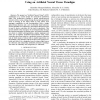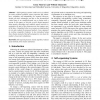6 search results - page 1 / 2 » Evolving a Scalable Multirobot Controller Using an Artificia... |
ICRA
2007
IEEE
13 years 11 months ago
2007
IEEE
CEC
2010
IEEE
13 years 6 months ago
2010
IEEE
For any embodied, mobile, autonomous agent it is essential to control its actuators appropriately for the faced task. This holds for natural organisms as well as for robots. If sev...
CEC
2009
IEEE
14 years 2 days ago
2009
IEEE
Abstract— In this paper we describe simulation of autonomous robots controlled by recurrent neural networks, which are evolved through indirect encoding using HyperNEAT algorithm...
GEM
2009
13 years 3 months ago
2009
Self-organizing systems could serve as a solution for many technical problems where properties like robustness, scalability, and adaptability are required. However, despite all the...
GECCO
1999
Springer
13 years 9 months ago
1999
Springer
This paper discusses the simulation results of a model of biological development for neural networks based on a regulatory genome. The model’s results are analyzed using the fra...



